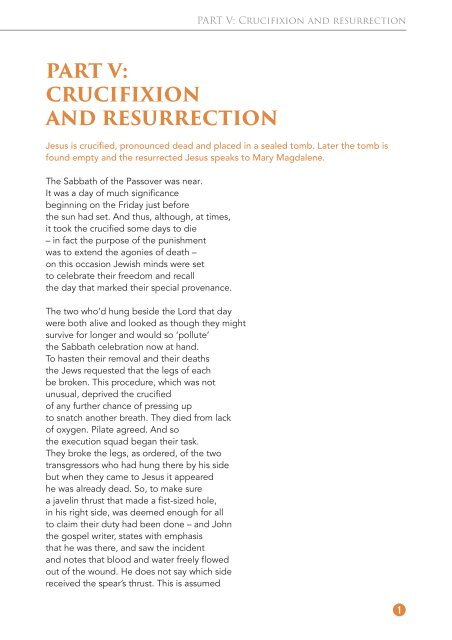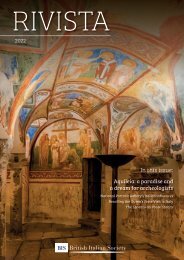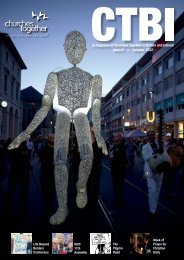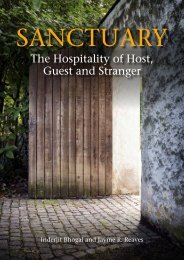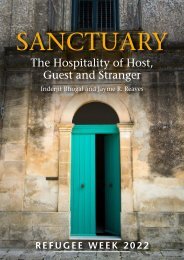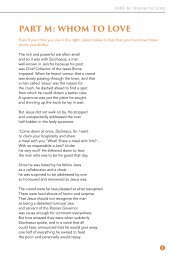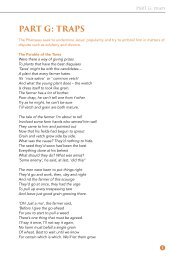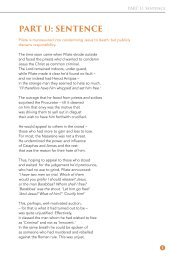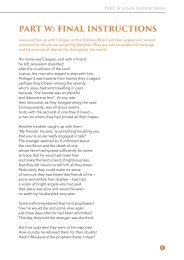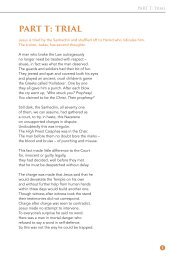A5- PART V
You also want an ePaper? Increase the reach of your titles
YUMPU automatically turns print PDFs into web optimized ePapers that Google loves.
<strong>PART</strong> V: Crucifixion and resurrection<br />
<strong>PART</strong> V:<br />
CRUCIFIXION<br />
AND RESURRECTION<br />
Jesus is crucified, pronounced dead and placed in a sealed tomb. Later the tomb is<br />
found empty and the resurrected Jesus speaks to Mary Magdalene.<br />
The Sabbath of the Passover was near.<br />
It was a day of much significance<br />
beginning on the Friday just before<br />
the sun had set. And thus, although, at times,<br />
it took the crucified some days to die<br />
– in fact the purpose of the punishment<br />
was to extend the agonies of death –<br />
on this occasion Jewish minds were set<br />
to celebrate their freedom and recall<br />
the day that marked their special provenance.<br />
The two who’d hung beside the Lord that day<br />
were both alive and looked as though they might<br />
survive for longer and would so ‘pollute’<br />
the Sabbath celebration now at hand.<br />
To hasten their removal and their deaths<br />
the Jews requested that the legs of each<br />
be broken. This procedure, which was not<br />
unusual, deprived the crucified<br />
of any further chance of pressing up<br />
to snatch another breath. They died from lack<br />
of oxygen. Pilate agreed. And so<br />
the execution squad began their task.<br />
They broke the legs, as ordered, of the two<br />
transgressors who had hung there by his side<br />
but when they came to Jesus it appeared<br />
he was already dead. So, to make sure<br />
a javelin thrust that made a fist-sized hole,<br />
in his right side, was deemed enough for all<br />
to claim their duty had been done – and John<br />
the gospel writer, states with emphasis<br />
that he was there, and saw the incident<br />
and notes that blood and water freely flowed<br />
out of the wound. He does not say which side<br />
received the spear’s thrust. This is assumed<br />
q
A gospel in blank verse with rhymed parables<br />
because a soldier’s training taught him how<br />
to concentrate his aim upon the side<br />
left unprotected by his enemy’s<br />
gripped shield. (The Turin Shroud confirms the wound<br />
if you believe that to be genuine.)<br />
Further the physiology makes clear<br />
that Jesus was already dead before<br />
the soldier’s final thrust was driven home.<br />
A soldier – a centurion he was –<br />
the ‘exactor mortis’, the very one<br />
in charge of staying with the crucified<br />
until the three were dead, had seen and heard<br />
all that had passed since noon upon that day.<br />
He was uniquely able to conclude<br />
that something very strange was happening.<br />
‘Oh, certainly this man was innocent,’<br />
he gasped.’ ‘His claim was true: he was indeed<br />
the Son of God.’ And those who’d stayed to see<br />
the death throes on the gibbets, moved away<br />
and beat their breasts in anguish and in fear.<br />
Joseph – a member of the Sanhedrin,<br />
a rich man of Judea from a place<br />
we can no longer now identify<br />
(Arimathea was its name) – was one<br />
of those whom Jesus had impressed. He was<br />
a man of courage and integrity.<br />
Careless of public reputation, he<br />
approached the Governor and requested that<br />
the body of the Lord be given him.<br />
He would arrange a quiet burial.<br />
Pilate expressed surprise that he was dead.<br />
He knew that crucifixion could take days.<br />
When the centurion in charge confirmed<br />
that Jesus, and the robbers were all dead<br />
permission was soon granted. Perhaps now<br />
might be the time when we can best describe<br />
the tomb that Joseph had in mind to lay<br />
to rest the life-less body of the man<br />
who’d so affected him. Joseph was rich.<br />
He’d had a new tomb dug out recently<br />
just for himself and for his family --<br />
a tomb that had been excavated from<br />
the rocky cliff-side close to Golgotha.<br />
w
<strong>PART</strong> V: Crucifixion and resurrection<br />
This was a fairly complex enterprise.<br />
Through solid rock they’d made an opening<br />
as big as was required to walk inside<br />
to find two largish chambers, hollowed out:<br />
the first a sort of vestibule, the next<br />
the tomb itself which was some six feet long<br />
but not as wide. Along one wall there was<br />
a kind of shelf with a substantial stone<br />
on which the body’s head could rest. Outside,<br />
to protect the corpse from desecration<br />
by animals or men intent to rob<br />
there was a very clever kind of door.<br />
A stone, shaped like a millstone or a wheel,<br />
ran down a sloping channel. It was large<br />
and heavy and was held in place by (a) wedge.<br />
A garden had been planted near the tomb<br />
and through this garden Joseph and a friend<br />
named Nicodemus carried in the corpse:<br />
This Nicodemus was the man who came<br />
to talk to Jesus very late at night:<br />
but now he brought the customary myrrh<br />
and aloes – a mix of perfumed resin –<br />
both needed to complete the burial.<br />
The men had wrapped already the dead Christ<br />
in linen shrouds, but left much else to do.<br />
The obsequies remaining to be done<br />
was work which, by long custom, had become<br />
the women’s privilege. There, standing close,<br />
as faithful to the Lord in death as they<br />
had been in life, were Mary Magdalene<br />
and Mary, wife of Zebedee, mother<br />
of James and John. They had begun their tasks<br />
but must leave them unfinished since the hour<br />
which marked the start of Sabbath intervened.<br />
The Law prescribed that all work had to stop.<br />
A delegation led by Caiaphas<br />
as soon as the restrictions of the Law<br />
were satisfied, including Pharisees,<br />
approached the Governor and put to him<br />
a problem they foresaw. They were afraid<br />
in case the Lord’s disciples should remove<br />
his body from the sepulchre and claim<br />
that he had risen from the dead as once<br />
he said he would: for such a fraud would cause<br />
e
A gospel in blank verse with rhymed parables<br />
more problems then, than if the man still lived.<br />
The so-called ‘king’ had been quite lawfully<br />
and properly despatched. His body now<br />
was lying in a tomb and that was where<br />
they wished it to remain. They’d like a squad<br />
of soldiers to stand guard. Pilate agreed.<br />
They marched off to the sepulchre and fixed<br />
a seal. The job was done: their cause had won.<br />
As dawn was breaking Mary Magdalene<br />
and Mary, mother of the younger James,<br />
Salome, too, also from Galilee<br />
came dashing to the tomb. They’d work to do.<br />
They needed to complete what they’d begun.<br />
The Sabbath was now over. They would start –<br />
at least they hoped they could – they were not sure<br />
because they knew they could not move the stone<br />
unless they had some help. They were surprised<br />
to find the entrance now agape. They paused:<br />
then went in quietly through the opening.<br />
They’d no idea at that time that the guards<br />
had felt the earth quake overnight and seen<br />
a figure, white and bright as lightning<br />
single-handed roll back the stone and sit<br />
upon it. Traumatised, the guards all lay,<br />
subdued by panic and afraid to move.<br />
With just a glance the women recognised<br />
the corpse had been removed. Without a word<br />
the Magdalena rushed away to take<br />
this most distressing news to all the rest<br />
of those who’d followed Jesus since the days<br />
he first began to teach in Galilee.<br />
She found young John and Peter and at once<br />
with anxious haste they ran ahead of her<br />
to see what they could make of this strange news.<br />
But John outran his elder and arrived<br />
to find that what the Magdalena said<br />
was true. Stooping and peering warily<br />
he saw no corpse but just the linen cloths<br />
which Joseph and which Nicodemus used.<br />
r
<strong>PART</strong> V: Crucifixion and resurrection<br />
But, true to form, Peter went straight inside.<br />
and there indeed were all the linen shrouds<br />
which Jews, by custom, used to clothe the dead.<br />
Only the napkin, covering the head,<br />
had been rolled up with care and placed elsewhere.<br />
Though John did not yet fully understand<br />
the import of the sight that met his eyes<br />
a transcendental feeling stayed with him<br />
that lasted all his life. Peter and he,<br />
perplexed and mystified, both left for home.<br />
By this time Mary Magdalene was back.<br />
She, Salome, and the other Mary<br />
went yet again to look inside the tomb<br />
and there they saw to their astonishment<br />
two figures, sitting on the ledge where once<br />
the body which they sought had been laid out.<br />
They were white-robed and shone as angels shine.<br />
‘Why do you seek the living (a)mong the dead?<br />
Remember what he said to you one day<br />
while he was still in Galilee: “I shall<br />
be made a prisoner and crucified,<br />
but on the third day I shall rise again.”<br />
He has risen. What he foretold was true.<br />
You must go back and tell the Twelve the news.<br />
Tell them that they will see him once again<br />
in Galilee. We are his messengers.<br />
It will be so. Go quickly. Tell them all.’<br />
But Mary Magdalene remained behind<br />
and let the others do what they’d been asked.<br />
She was exhausted. She had spent her day<br />
thus far relaying messages. Perhaps<br />
she could anticipate the way the facts<br />
would be received – with scorn and disbelief:<br />
for no mere women would be credited<br />
as bearers of such overwhelming news.<br />
And so she sat among the trees and flowers<br />
and wept as if her heart would break....... until<br />
a man approached. She turned to look at him.<br />
He seemed concerned. ‘What are you crying for?<br />
he asked. She thought the garden might be his.<br />
Perhaps he worked there: and perhaps he’d know<br />
where she might find the body that she sought.<br />
t
A gospel in blank verse with rhymed parables<br />
‘Whom are you looking for?’ he asked. ‘Jesus’<br />
she said. ‘His corpse was lying in a tomb:<br />
here, in the garden. Sir, I owed him much<br />
and came to treat his body with respect.<br />
You see, I have got myrrh and aloes here.<br />
If you have moved him, tell me where he is.’<br />
But all he said, in her own dialect,<br />
with a familiar lilt she recognised<br />
was ‘Mary!’ ‘Oh! Rabboni!’ she exclaimed<br />
and moved to hug the man she’d thought was dead.<br />
The Lord drew back. ‘Please do not touch me yet.<br />
My Father waits for me and I must first<br />
ascend to Him – to my God and to yours:<br />
they are the same. What you must do is go<br />
and tell my friends I’ll see them very soon<br />
in Galilee.’<br />
Meanwhile, the tomb guards were recovering.<br />
Shame-faced, yet still astonished at the sight<br />
that had so frightened them, they went to seek<br />
the Chief Priests to report the happening<br />
and to explain how they had failed their duty.<br />
There was no doubting here, and hastily<br />
the Sanhedrin was called to contemplate<br />
how best to make sure that this incident<br />
was buried and not quickly spread abroad.<br />
The soldiers’ palms were greased. They were to say<br />
that they had been asleep on guard and that<br />
the body had been stolen by his friends.<br />
They would square Pilate. Leave it all to them.<br />
This lie became the common currency.<br />
y


